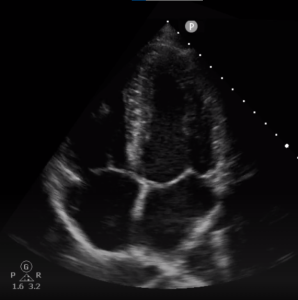The EchoGo Heart Failure platform is an FDA-approved echocardiogram model used to detect a disease.

An Apical 4 Chamber Echocardiogram
Echocardiography is generally the first test administered when heart failure is suspected in a patient. The procedure commonly evaluates diastolic function, the heart’s ability to relax and fill the lower chambers with blood. Each assessment involves multiple echocardiographic and Doppler measurements, which provide insight into the structure and blood flow of the heart, to characterize a patient’s diastolic function. However, it is not uncommon for some of the measurements to be inconsistent or unavailable. As a result, assessments can be inconclusive as often as 40% of the time.
Heart failure with preserved ejection fraction (HFpEF) is when the left ventricle of the heart cannot relax or fill fully, making it difficult for the heart to properly fill with blood when beating. It is a challenge to identify, as it requires assessment of diastolic function. This condition is a growing clinical problem and accounts for about half of the cases of heart failure. Patricia Pellikka, M.D., a cardiology consultant at Mayo Clinic, and her team went in search of a solution.
From idea to reality

Patricia A. Pellikka, M.D.
In 2019, the American Society of Echocardiography offered a special grant to promote research partnerships between clinician scientists and engineering scientists that addressed a major clinical problem in cardiovascular ultrasound imaging. Dr. Pellikka had an idea that could make use of the grant. “I hypothesized that detection of diastolic dysfunction and heart failure with preserved ejection fraction might be possible by applying artificial intelligence to a standard echocardiographic view,” says Dr. Pellikka.. She submitted a proposal, and she and her team were awarded the grant.
After seeking software engineering resources for nearly a year, she met the CEO of Ultromics, a United Kingdom-based company specializing in AI programming. Mayo Clinic Ventures assisted Dr. Pellikka in negotiations. With Dr. Pellikka’s clinical expertise and Ultromics’ engineering knowledge, the AI model was created.
This new algorithm, now approved by the FDA, has great potential to advance patient care and change medical practice. It works by having the algorithm analyze a video of an apical 4 chamber (A4C) view, a common ultrasound test that shows all four chambers of the heart and has the potential to improve the accuracy and efficiency of detecting heart failure with preserved ejection fraction. Thanks to this technology, heart failure diagnosis may now be possible even when typical detection modalities, such as comprehensive echo-Doppler assessment and right-heart catheterization, are not immediately available. This could lead to faster diagnosis, more timely treatment and better patient outcomes.
Looking to the future
The AI model is now being used to expedite the diagnosis of heart failure with preserved ejection fraction across the U.S.
“Ours was the first FDA approved echocardiogram model to detect a disease and the first FDA approved model in Mayo Clinic’s Department of Cardiovascular Medicine,” says Dr. Pellikka. “Since we begin working on this, new treatments for HFpEF have become available, and the application of our model allows patients to get a correct diagnosis more expeditiously so that they can begin treatment.”
Dr. Pellikka’s work isn’t finished. She and her team continue to collaborate with Ultromics to adapt the AI to detect other diseases with echocardiography in hopes that this is just the beginning for this nascent technology.
Share this story
Mayo Clinic has a financial interest in the technology referenced in this press release. Mayo Clinic will use any revenue it receives to support its not-for-profit mission in patient care, education and research.
